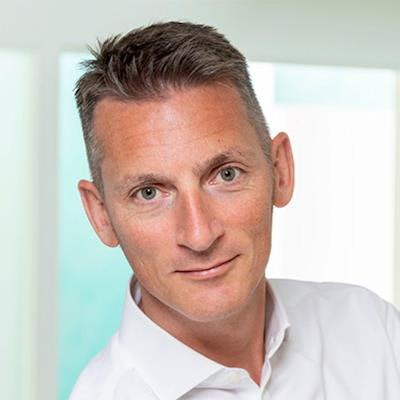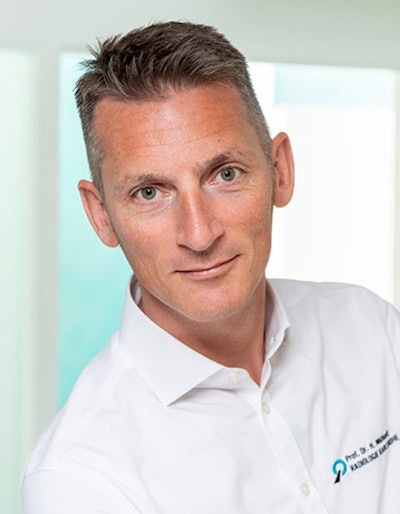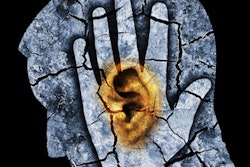
Sustainability has long been a topic of debate in the healthcare sector, but usually in connection with clinics and hospitals. In this Q&A interview with the German Röntgen Society (Deutsche Röntgengesellschaft, DRG), Prof. Dr. Henrik Michaely, medical director and CEO of the MVZ Radiology Karlsruhe and chairman of the DRG's Forum of Radiologists in Private Practice (FuNRad), elaborates on how private radiology practice can be more sustainable.
Q: Why is climate and environmental protection so important to your practice?
 Prof. Dr. Henrik Michaely, courtesy of MVZ Radiologie Karlsruhe.
Prof. Dr. Henrik Michaely, courtesy of MVZ Radiologie Karlsruhe.A: On the one hand, it's due to my personal, very positive attitude toward the issues of climate and environmental protection. On the other hand, there are also medical reasons. Climate protection is not only important for preserving nature but also for everyone's health. A healthier climate, less pollution, and healthier cities also lead to a certain degree to fewer illnesses.
Q: Could you give some concrete examples of sustainability in your branch practice?
A: Sustainability at the branch practice has many facets. For example, we work primarily paperlessly and digitally. This saves resources and also leads to more efficient organization of the day-to-day running of the practice. We also work without CDs, i.e., mainly with digital distribution of findings and images. In this way, we significantly reduce the use of raw materials, as CDs often end up in data waste.
Another example of sustainability in our practice is the use of contrast media. Here, we make sure that we use imaging methods that are good for the environment, reducing contrast media consumption while maintaining the same medical quality -- which is always the prerequisite.
Reducing consumption is a good motto, also for energy, because the need for electricity in radiology is exorbitantly high. A practice consumes around 100,000 kilowatt-hours per year per KV site. By comparison, private households have an annual consumption of around 3,000 kilowatt-hours, so what we use in radiology practices is considerable. In our practice, we save "expensively" by purchasing new and energy-saving equipment, but also "more cheaply" by retrofitting our equipment. We also implement smaller measures such as replacing lamps, for example.
Q: When replacing equipment in your practice, what happens to the old devices?
A: The old devices are usually removed and either recycled proportionally, i.e., used as spare parts for systems that still exist, or they are re-used in other locations, countries, or practices, depending on their age. This depends on the device manufacturer and the age of the device. The older the device that is being removed, the less likely it is to find a home somewhere. The newer the device, the more likely it can be reused in its entirety.
Q: Is upgrading or retrofitting equipment an alternative to replacing it?
A: Yes and no. Upgrading and retrofitting sounds good. It often works in practice, but not always. As described, it depends on the manufacturer, the year of manufacture, and what the manufacturer wants to do. For example, with MRI machines, you can often keep the actual magnets for a long time because they do not lose any of their quality. But the components attached to the magnet, such as the radiofrequency generators or measuring and receiving parts, have to be replaced during the upgrade. This is an environmentally friendly method, where the costs for installation and conversion should also be lower.
Q: How do you estimate the financial outlay for sustainability measures? Will this result in economic benefits in the long term?
A: The phrase "long term" is very important here. I think that nothing you do in this area has a positive financial impact in the short term, which is when the expenditure is always felt. But, in the long term, measures for more sustainability pay off, for example when you purchase new equipment.
If a new device uses less electricity, it will be cheaper to operate over time. In the case of the power supply itself, for example, we recently installed a stand-alone device that cushions voltage fluctuations by storing and releasing power. This reduces our power consumption by 15% on average. This device will pay for itself in eight years, which is a long-term result. So it takes a little bit of long-sightedness; nothing happens overnight.
Q: Is it harder or easier to implement sustainability in a private local practice than, for example, in the radiology department of a large hospital?
A: Much easier! During my time as a senior physician at the Institute for Clinical Radiology in Mannheim, I noticed that in a large hospital you have relatively little chance to change anything in terms of building services, purchasing, and the like.
I believe that you can only act sustainably in a clinic if the clinic as a whole is committed to sustainability. If not, it's hard. In a private practice, you have more opportunities to influence, for example, the purchase of equipment or the electricity supplier, and thus the type of electricity you want to purchase.
Q: Beyond the ecological dimension, how do you implement sustainability on a social level, in terms of how you treat patients or employees?
A: We implement the social dimension of sustainability by practicing tolerance and being open to all employees as a company. We also want to offer patients excellent service as the best possible provider on the market. Our aspiration -- even if we are driven by criteria of profitability -- is to deliver the best medical quality for all our patients. This is what we mean by social sustainability.
Editor's note: This is an edited version of a translation of an article published in German online by the DRG. Translation by Frances Rylands-Monk. To read the original version, go to the DRG website.



















